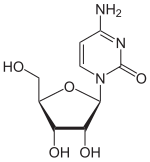Cytidine
Appearance
 | |
 | |
| Names | |
|---|---|
| IUPAC name
Cytidine
| |
| Systematic IUPAC name
4-Amino-1-[(2R,3R,4S,5R)-3,4-dihydroxy-5-(hydroxymethyl)oxolan-2-yl]pyrimidin-2(1H)-one | |
| Other names
4-Amino-1-β-D-ribofuranosyl-2(1H)-pyrimidinone[1]
4-Amino-1-[3,4-dihydroxy-5-(hydroxymethyl)tetrahydrofuran-2-yl]pyrimidin-2-one | |
| Identifiers | |
3D model (
JSmol ) |
|
| ChEBI | |
| ChEMBL | |
| ChemSpider | |
ECHA InfoCard
|
100.000.555 |
IUPHAR/BPS |
|
| KEGG | |
| MeSH | Cytidine |
PubChem CID
|
|
| UNII | |
CompTox Dashboard (EPA)
|
|
| |
SMILES
| |
| Properties | |
| C9H13N3O5 | |
| Molar mass | 243.217 |
| Appearance | white, crystalline powder[2] |
| Melting point | 230 °C (decomposes)[1] |
| −123.7·10−6 cm3/mol | |
Except where otherwise noted, data are given for materials in their standard state (at 25 °C [77 °F], 100 kPa).
| |
Cytidine (
ribofuranose) via a β-N1-glycosidic bond. Cytidine is a component of RNA. It is a white water-soluble solid[2] that is only slightly soluble in ethanol.[1]
Dietary sources
Dietary sources of cytidine include foods with high RNA (ribonucleic acid) content,[3] such as organ meats, brewer's yeast, as well as pyrimidine-rich foods such as beer. During digestion, RNA-rich foods are broken-down into ribosyl pyrimidines (cytidine and uridine), which are absorbed intact.[3] In humans, dietary cytidine is converted into uridine,[4] which is probably the compound behind cytidine's metabolic effects.
Cytidine analogues
A variety of cytidine
epigenetic demethylation.[6]
Biological actions
In addition to its role as a
glutamate cycling, with supplementation decreasing midfrontal/cerebral glutamate/glutamine levels.[7] As such, cytidine has generated interest as a potential glutamatergic antidepressant drug.[7]
Related compounds
- Deoxycytidine is cytosine attached to a deoxyribose.
Properties
This section is empty. You can help by adding to it. (March 2024) |
References
- ^ ISBN 978-1-4987-5429-3.
- ^ ISBN 978-1-118-13515-0.)
{{cite book}}: CS1 maint: multiple names: authors list (link - ^ PMID 11786646.
- S2CID 18687483.
- ^ John S. James. "New Kind of Antiretroviral, KP-1461". AIDS Treatment News. Archived from the original on 2019-03-30. Retrieved 2012-03-23.
- ^ "Scientists reprogram cancer cells with low doses of epigenetic drugs". Medical XPress. March 22, 2012.
- ^ PMID 20419280.
